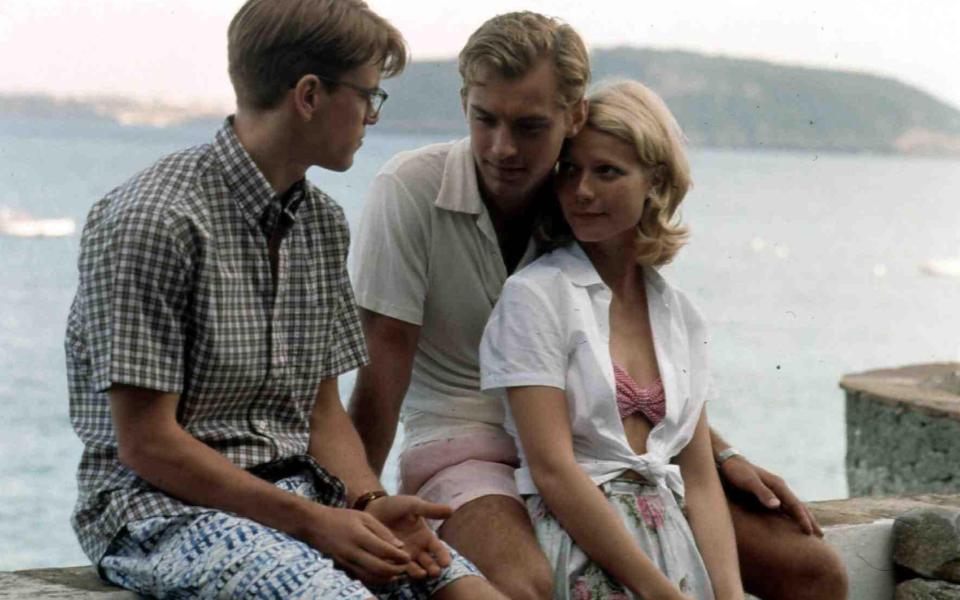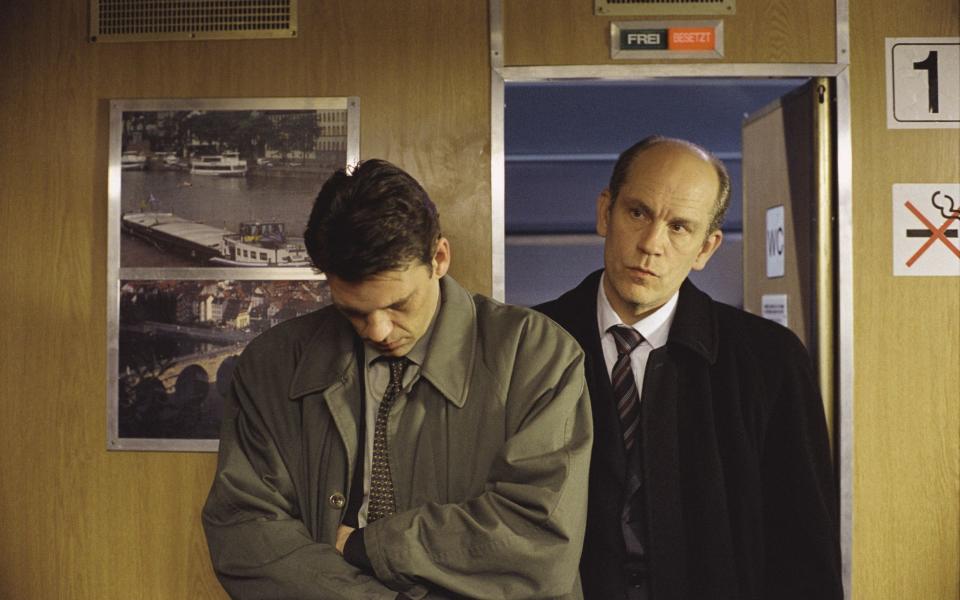‘She was obsessed with what it took to commit murder’: the dark heart of Patricia Highsmith
!['I often had the feeling that Ripley was writing [the story] and I was merely typing it.' Patricia Highsmith, pictured in 1987](https://s.yimg.com/ny/api/res/1.2/aehK3T8dUUxGB7ld55dZ6g--/YXBwaWQ9aGlnaGxhbmRlcjt3PTEyNDI7aD03NzY-/https://media.zenfs.com/en/the_telegraph_258/eb9076da3e7dd61c2dcdde1c0f0c249f)
- Oops!Something went wrong.Please try again later.
- Oops!Something went wrong.Please try again later.
- Oops!Something went wrong.Please try again later.
In late October 1951, the 31-year-old author Patricia Highsmith travelled to Positano on the Amalfi Coast, attempting to escape from the complications of her life and career in the US. Her second novel, lesbian romance The Price of Salt – later filmed as Carol, starring Cate Blanchett – was a disappointment, and she described her $6,500 advance as “an impressive fee for unimpressive writing”.
Yet as Highsmith stood on the balcony of her hotel, she caught sight of a “solitary young man in shorts and sandals with a towel flung over his shoulder, making his way along the beach from right to left. He was looking downward... I could just see that his hair was straight and darkish.”
Although Highsmith was a lesbian, she was fascinated by this figure in a way that transcended conventional physical desire. As she later wrote in an autobiographical essay for Granta, ‘The Scene of the Crime’, “There was an air of pensiveness about him, maybe unease. And why was he alone? He did not look like the athletic type who would take a cold swim alone at an early hour. Had he quarrelled with someone? What was on his mind? I never saw him again. I did not even write anything in my cahier about him. What would there have been to say? He looked like a thousand other American tourists in Europe that summer.”
A few months later, Highsmith came up with the detail that would become the kernel of her 1955 novel The Talented Mr Ripley: “of a young American drifter being sent to Europe to bring another American back home, if possible.” Here was Tom Ripley, the “suave, agreeable and utterly amoral” protagonist of five novels, published between 1955 and 1991.
Ripley is introduced as a low-level conman who finds himself recruited by the father of a vague acquaintance, Dickie Greenleaf, to head to Italy and retrieve his son from bohemian ways. Ripley takes to his task with rather too much brio, murdering Dickie and assuming his identity, and using his wiles to dance around both the Italian police force and Dickie’s suspicious girlfriend Marge Sherwood. He ends the novel both triumphant and free, albeit forever looking over his shoulder. The subsequent books in which he appears see him further his nefarious antics throughout Europe, even as he declares (in the third in the series, Ripley’s Game) that “I detest murder, unless it’s absolutely necessary.” Ripley is cultured, civilised and probably at least bisexual, although he is married in later books.
The character, unsurprisingly, remains catnip for filmmakers and actors. Those who have played him include Matt Damon, Alain Delon and actor-turned-director Jonathan Kent, who played him in a South Bank Show special. Highsmith told the show’s director Jack Bond’s that he was: “goddamn f***ing lucky – he’s perfect.”
Now, the award-winning actor Andrew Scott is to play the killer in a new Netflix series simply entitled Ripley. It is not so much a thriller as an intensely focused character study, until, that is, the plot mechanics kick in and the murdering begins.
Whether Ripley will erase memories of Anthony Minghella’s magnificent, operatic 1999 adaptation of The Talented Mr Ripley remains to be seen, but at the very least it will bring one of the 20th century’s most famous anti-heroes back into public visibility. Ripley was also well served by John Malkovich in Ripley’s Game, which was co-written by actor and screenwriter Charles McKeown.
McKeown is rare amongst adapters of Highsmith’s work in that he met the writer herself. By his own admission, he had been “attracted, repelled and fascinated” by the Ripley novels. He tells me: “She didn’t talk about her work, but we discussed her beloved Siamese cats of which she had painted some terrific watercolour portraits.” Yet the feline banter was a means of keeping the wider world at bay. A mutual friend of both parties told McKeown firstly that Highsmith had a very difficult relationship with her mother, which led to the misanthropy and suspicion inherent in her writing, and secondly that she lacked a quality that all great writers are supposed to possess: objectivity. As the friend sighed, “The problem is, Highsmith is in love with Ripley.”
But Highsmith’s relationship with Ripley transcended love. While she was writing The Talented Mr Ripley, she realised that the way to create an indelible character was to inhabit him as fully as an actor might assume a part; as she said, saluting his “insolence and audacity”, “by thinking myself inside the skin of such a character, my own prose became more self-assured than it logically should have been… it became entertaining.”

The author knew, from the outset, that she was onto a winner. Highsmith wrote in her diary on May 12 1954 that she was very happy and that “the sentences of the book go down on the paper like nails…the whole reads very strong at present”. Yet her aim was a controversial, even shocking one. She wrote on October 1 that “[I am] showing the unequivocal triumph of evil over good, and rejoicing in it. I shall make my readers rejoice in it, too.” She succeeded. The reviews were excellent, although not without a touch of concern at how strongly the writer empathised with her anti-hero: the New Yorker’s critic called Ripley “one of the most repellent and fascinating characters in contemporary literature”.
Highsmith was not a sentimental woman, as those who worked with her and (occasionally) loved her soon came to realise. Yet she felt a remarkable sense of loyalty towards her favourite character, who, as McKeown remarks, “is diminished by analysis. To describe him as a psychopath, for example, or to give him an explanatory sociological profile is, in my opinion, to deprive him of his mythological status. He just is… and does. Unlike, in the main, us mortals.”
Ripley, as portrayed in the novels, thought and spoke like Highsmith, allowing the author a remarkable degree of autobiographical freedom with her creation. She once wrote: “I often had the feeling that Ripley was writing [the story] and I was merely typing it.” One interviewee in Andrew Wilson’s definitive biography of Highsmith, Beautiful Shadow, told him that “After Pat’s death, John Mortimer wrote a tribute, saying he thought she was in love with Mr Ripley, but actually, she was Ripley, or, I should say, she would have liked to have been him.”

Of course, Highsmith’s own life was eventful. The author Jill Dawson wrote an acclaimed 2016 novel, The Crime Writer, in which she focuses on the time Highsmith retreated to Suffolk in 1964 to escape the attentions of fans and lovers, and to write the novel A Suspension of Mercy. Yet the character is haunted by both the ghosts of the characters she has created and her own psyche, declaring at one point that “Violence is not an act, it’s a feeling.”
Dawson comments that “Highsmith was obsessed with what it took to commit a murder. She said that she thought about this every single day, which is a strange admission.”
She adds: “I think that ‘over empathising’ is probably natural for a writer of her calibre.”
Recently, there have been plans for a psychological thriller, Switzerland, to be directed by Anton Corbijn with Helen Mirren as Highsmith. The picture will revolve around the ageing author living in isolation in the Swiss Alps and the battle of wits that develops between her and a young literary agent when he arrives at her house with the intention of persuading her to write a final novel in the Ripley series. Although filming has yet to begin, the producers declared that “Patricia Highsmith and Tom Ripley are box office gold” and suggested that Mirren was perfect casting, on the grounds that “she will be perfect at encapsulating Highsmith’s icy threat and her blend of monstrosity and vulnerability”.
Highsmith, for all her flaws and foibles, was only human, and subject to the vagaries of physical illness and heartbreak. Yet the greatest gift (or curse) that the writer bequeathed her legions of admirers was one of the most indelible characters in literature.
Ripley is on Netflix from Thursday April 4

